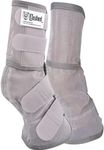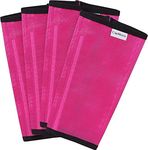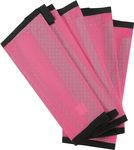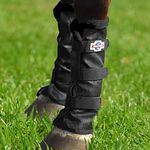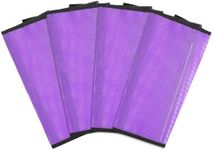Buying Guide for the Best Fly Boots For Horses
Choosing the right fly boots for horses is important to keep your horse comfortable and protected from biting insects during the warmer months. Fly boots are designed to cover your horse’s lower legs, preventing flies and other pests from irritating the skin, which can lead to stomping, stress, and even injury. When shopping for fly boots, it’s essential to consider your horse’s specific needs, the environment, and how often your horse will wear them. Understanding the key features will help you make a choice that keeps your horse happy and healthy.MaterialThe material of fly boots is crucial because it affects breathability, durability, and comfort. Most fly boots are made from mesh or lightweight synthetic fabrics that allow air to flow while keeping insects out. Some materials are softer and more flexible, which is good for sensitive horses, while others are sturdier and last longer. If your horse is in a hot climate or wears boots for long periods, prioritize breathable, soft mesh. For rougher environments or active horses, look for tougher, reinforced materials.
Fit and SizeFit and size determine how well the boots stay on and how comfortable they are for your horse. Boots that are too tight can cause rubbing and sores, while loose boots may slip or let insects in. Fly boots usually come in sizes like small, medium, large, or are adjustable with Velcro straps. Measure your horse’s legs and check sizing guides to ensure a snug but not restrictive fit. If your horse has unusually shaped legs or is between sizes, adjustable boots are a good choice.
Closure TypeClosure type refers to how the boots fasten around your horse’s legs, commonly using Velcro straps or hook-and-loop systems. This is important for ease of use and security. Multiple wide straps provide a more secure fit and are less likely to come undone, while single or narrow straps are quicker to put on but may not stay in place as well. If your horse is active or tends to remove boots, opt for boots with strong, multiple closures.
Coverage and HeightCoverage and height describe how much of the leg the boot protects. Some fly boots cover just the lower leg, while others extend up to the knee or hock. More coverage offers better protection but can be warmer and may restrict movement if not designed well. For horses in areas with lots of biting insects or those prone to skin irritation, taller boots are beneficial. For horses in milder conditions or those sensitive to heat, shorter boots may be more comfortable.
DurabilityDurability is about how well the boots hold up to regular use, especially if your horse is turned out in rough terrain or is very active. Reinforced stitching, strong materials, and quality closures all contribute to longer-lasting boots. If your horse is gentle and mostly in a clean paddock, lighter boots may suffice. For horses that play hard or are in rocky or brushy areas, prioritize boots known for their toughness.
Ease of CleaningEase of cleaning matters because fly boots can get dirty quickly, especially in muddy or dusty environments. Some boots are machine washable, while others need to be hand-washed. If you want low-maintenance care, look for boots that are easy to rinse or toss in the washing machine. For horses in clean, dry areas, cleaning may be less of a concern.


